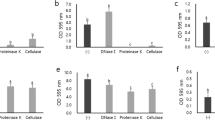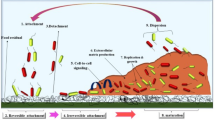Abstract
Sanitizing effect of ethanol on a Yersinia enterocolitica biofilm was evaluated in terms of biomass removal and bactericidal activity. We found that 40 % ethanol was most effective for biofilm biomass removal; however, no significant difference was observed in bactericidal activity between treatment with 40 and 70 % ethanol. This unexpected low ethanol concentration requirement for biomass removal was confirmed using biofilms of two additional pathogenic bacteria, Aeromonas hydrophila and Xanthomonas oryzae. Although only three pathogenic Gram-negative bacteria were tested and the biofilm in nature was different from the biofilm in this study, the results in this study suggested the possible re-evaluation of the effective sanitizing ethanol concentration 70 %, which is the concentration commonly employed for sanitization, on bacteria in a biofilm.



Similar content being viewed by others
References
Abdel-Haq NM, Asmar BI, Abuhammour WM, Brown WJ (2000) Yersinia enterocolitica infection in children. Pediatr Infect Dis J 19:954–958
Ali Y, Dolan MJ, Fendler EJ, Larson EL (2001) Alcohols. In: Block SS (ed) Disinfection, sterilization, and preservation, 5th edn. Lippincott Williams & Wilkins, Philadelphia, pp 229–253
Alves FRF, Silva MG, Rôças IN, Siqueira JF Jr (2013) Biofilm biomass disruption by natural substances with potential for endodontic use. Braz Oral Res 27:20–25
Aumeran C, Guyot P, Boisnoir M, Robin-Hennequin C, Vidal M, Forestier C, Traore O, Lesens O (2013) Activity of ethanol and daptomycin lock on biofilm generated by an in vitro dynamic model using real subcutaneous injection ports. Eur J Clin Microbiol 32:199–206
Bernal P, Llamas MA (2012) Promising biotechnological applications of antibiofilm exopolysaccharides. Microb Biotechnol 5:670–673
Chaudhury A, Rangineni J (2012) Catheter lock technique: in vitro efficacy of ethanol for eradication of methicillin-resistant staphylococcal biofilm compared with other agents. FEMS Immunol Med Mic 65:305–308
Corbin A, Pitts B, Parker A, Stewart PS (2011) Antimicrobial penetration and efficacy in an in vitro oral biofilm model. Antimicrob Agents Chemother 55:3338–3344
Donlan RM, Costerton JW (2002) Biofilms: survival mechanisms of clinically relevant microorganisms. Clin Microbiol Rev 15:167–193
Freitas F, Alves VD, Reis MA (2011) Advances in bacterial exopolysaccharides: from production to biotechnological applications. Trends Biotechnol 29:388–398
Keren I, Kaldalu N, Spoering A, Wang Y, Lewis K (2004) Persister cells and tolerance to antimicrobials. FEMS Microbiol Lett 230:13–18
Khalil MAM, Rehman A, Kashif WU, Rangasami M, Tan J (2013) A rare case of Aeromonas hydrophila catheter related sepsis in a patient with chronic kidney disease receiving steroids and dialysis: a case report and review of Aeromonas infections in chronic kidney disease patients. Case Rep Nephrol 2013:1–5
Kim T-J, Young BM, Young GM (2008) Effect of flagellar mutations on Yersinia enterocolitica biofilm formation. Appl Environ Microbiol 74:5466–5474
Kirov SM, Castrisios M, Shaw JG (2004) Aeromonas flagella (polar and lateral) are enterocyte adhesins that contribute to biofilm formation on surfaces. Infect Immun 72:1939–1945
Kubiak DW, Gilmore ET, Buckley MW, Lynch R, Marty FM, Koo S (2014) Adjunctive management of central line-associated bloodstream infections with 70 % ethanol-lock therapy. J Antimicrob Chemother 69:1665–1668
Lewis K (2001) Riddle of biofilm resistance. Antimicrob Agents Chemother 45:999–1007
McGarey D, Milanesi L, Foley D, Reyes BJ, Frye L, Lim D (1991) The role of motile aeromonads in the fish disease, ulcerative disease syndrome (UDS). Experientia 47:441–444
McLeod BR, Fortun S, Costerton JW, Stewart PS (1999) Enhanced bacterial biofilm control using electromagnetic fields in combination with antibiotics. In: Ron JD (ed) Methods in enzymology, vol 310. Academic Press, London, pp 656–670
Metcalf SCL, Chambers ST, Pithie AD (2004) Use of ethanol locks to prevent recurrent central line sepsis. J Infect 49:20–22
Morton HE (1950) The relationship of concentration and germicidal efficiency of ethyl alcohol. Ann NY Acad Sci 53:191–196
Öncü S (2014) Optimal dosage and dwell time of ethanol lock therapy on catheters infected with Candida species. Clin Nutr 33:360–362
O’Toole G, Kaplan HB, Kolter R (2000) Biofilm formation as microbial development. Annu Rev Microbiol 54:49–79
Parsek MR, Singh PK (2003) Bacterial biofilms: an emerging link to disease pathogenesis. Annu Rev Microbiol 57:677–701
Peters BM, Ward RM, Rane HS, Lee SA, Noverr MC (2013) Efficacy of thanol against Candida albicans and Staphylococcus aureus polymicrobial biofilms. Antimicrob Agents Chemother 57:74–82
Qu Y, Istivan TS, Daley AJ, Rouch DA, Deighton MA (2009) Comparison of various antimicrobial agents as catheter lock solutions: preference for ethanol in eradication of coagulase-negative staphylococcal biofilms. J Med Microbiol 58:442–450
Rediske AM, Roeder BL, Nelson JL, Robison RL, Schaalje GB, Robison RA, Pitt WG (2000) Pulsed ultrasound enhances the killing of Escherichia coli biofilms by aminoglycoside antibiotics in vivo. Antimicrob Agents Chemother 44:771–772
Sakthivel N, Mortensen C, Mathur S (2001) Detection of Xanthomonas oryzae pv. oryzae in artificially inoculated and naturally infected rice seeds and plants by molecular techniques. Appl Microbiol Biotechnol 56:435–441
Shen Y, Ronald P (2002) Molecular determinants of disease and resistance in interactions of Xanthomonas oryzae pv. oryzae and rice. Microbes Infect 4:1361–1367
Spoering AL, Lewis K (2001) Biofilms and planktonic cells of Pseudomonas aeruginosa have similar resistance to killing by antimicrobials. J Bacteriol 183:6746–6751
Tsuge S, Furutani A, Fukunaka R, Oku T, Tsuno K, Ochiai H, Inoue Y, Kaku H, Kubo Y (2002) Expression of Xanthomonas oryzae pv. oryzae hrp genes in XOM2, a novel synthetic medium. J Gen Plant Pathol 68:363–371
Venkatesh M, Rong L, Raad I, Versalovic J (2009) Novel synergistic antibiofilm combinations for salvage of infected catheters. J Med Microbiol 58:936–944
Wong HS, Townsend KM, Fenwick SG, Maker G, Trengove RD, O’Handley RM (2010) Comparative susceptibility of Salmonella Typhimurium biofilms of different ages to disinfectants. Biofouling 26:859–864
Zakhari S (2006) Overview: how is alcohol metabolized by the body? Alcohol Res Health 29:245–254
Zhang Y, Wei C, Jiang W, Wang L, Li C, Wang Y, Dow JM, Sun W (2013) The HD-GYP domain protein RpfG of Xanthomonas oryzae pv. oryzicola regulates synthesis of extracellular polysaccharides that contribute to biofilm formation and virulence on rice. PLoS One 8:e59428
Acknowledgments
We thank Dr. Jin-Hyun Kim for generously providing the A. hydrophila strain. This work was supported by a Grant from the Next-Generation BioGreen 21 Program (No. PJ009490), Rural Development Administration, Republic of Korea.
Author information
Authors and Affiliations
Corresponding author
Rights and permissions
About this article
Cite this article
Park, HS., Ham, Y., Shin, K. et al. Sanitizing Effect of Ethanol Against Biofilms Formed by Three Gram-Negative Pathogenic Bacteria. Curr Microbiol 71, 70–75 (2015). https://doi.org/10.1007/s00284-015-0828-4
Received:
Accepted:
Published:
Issue Date:
DOI: https://doi.org/10.1007/s00284-015-0828-4




